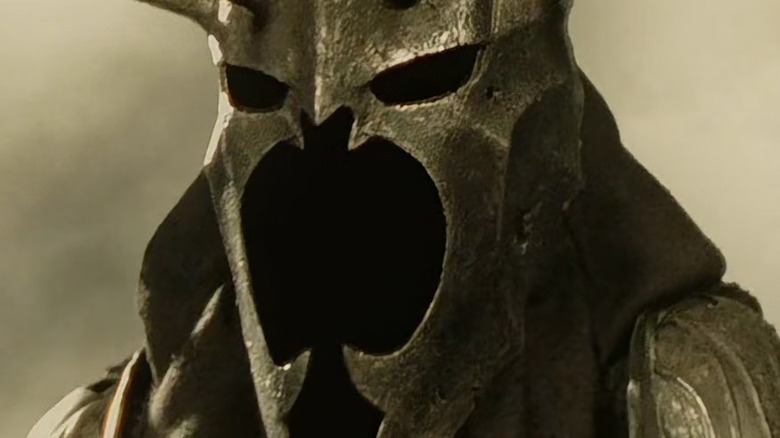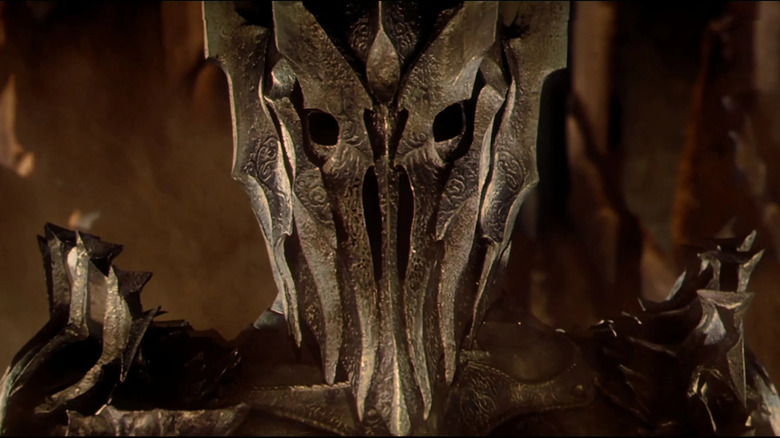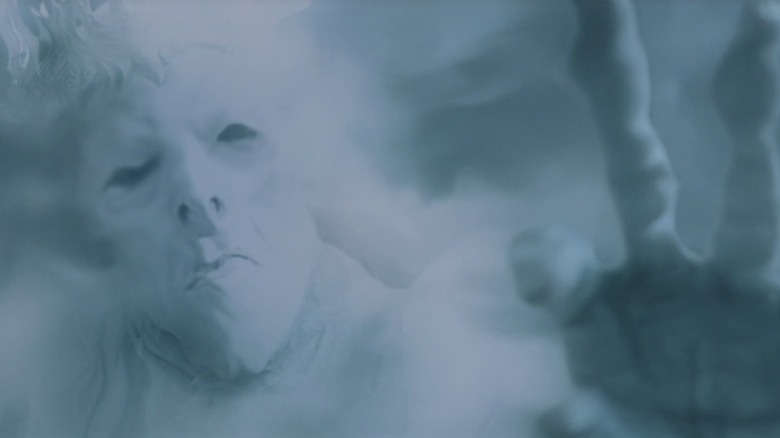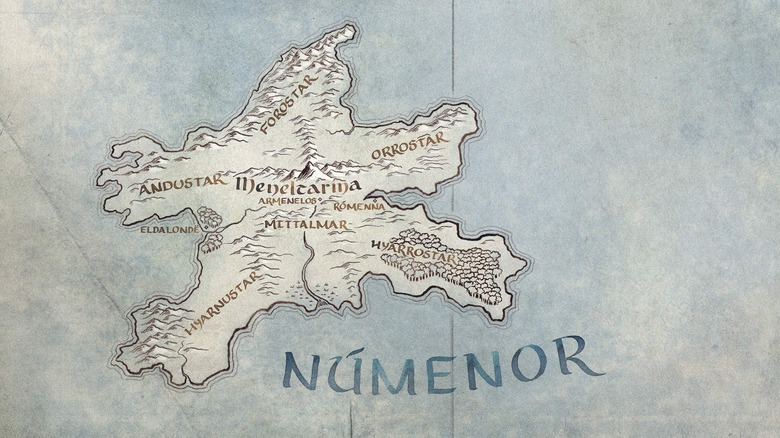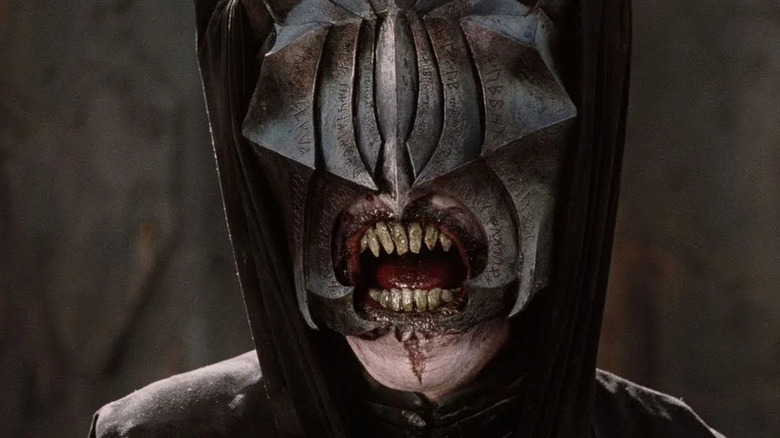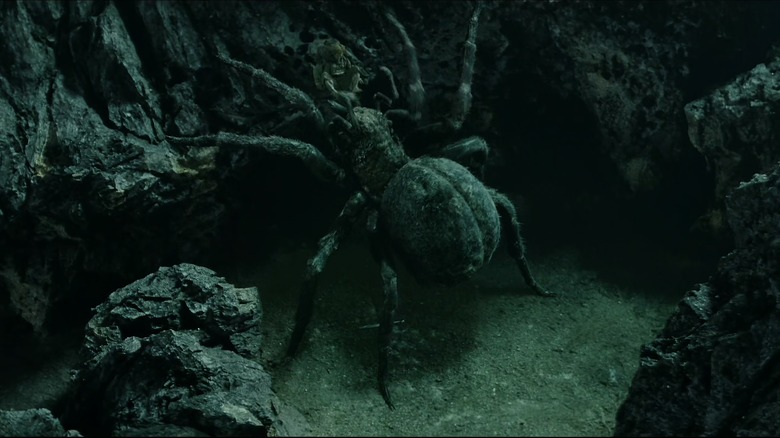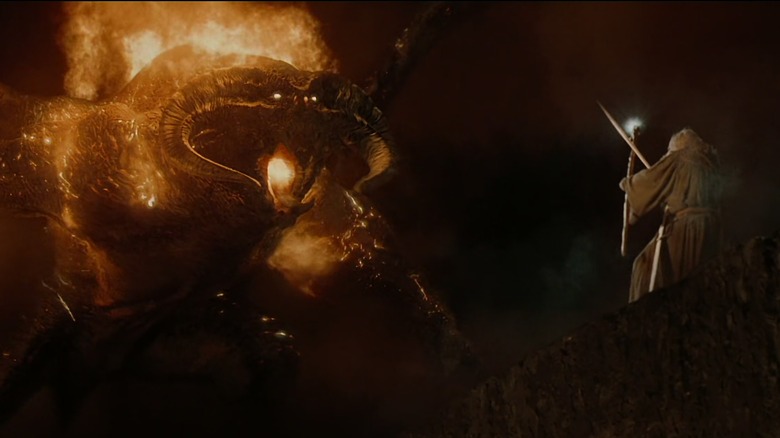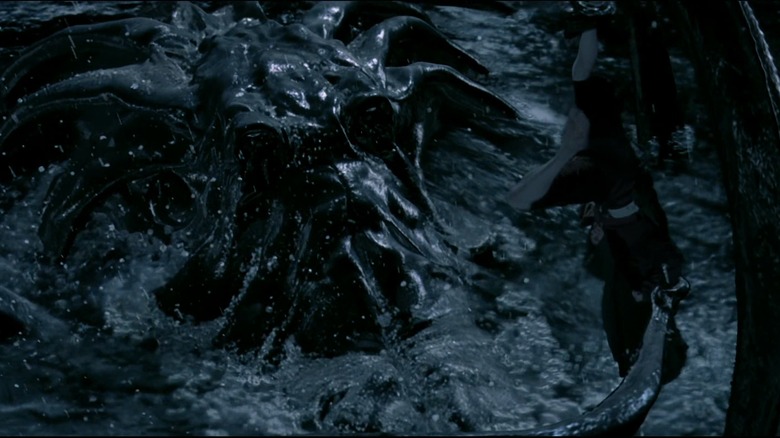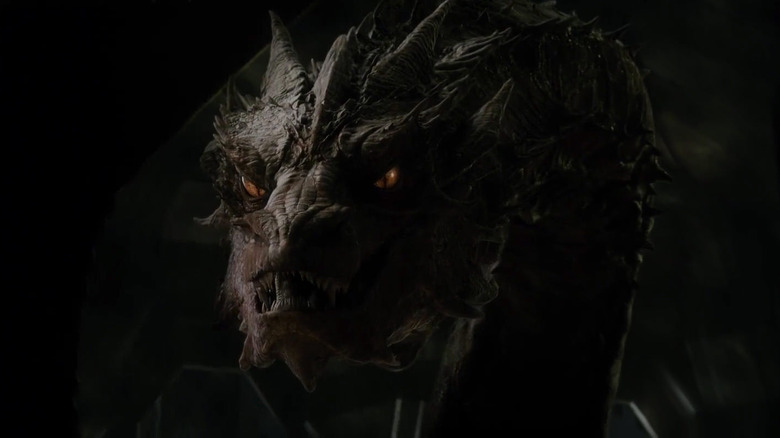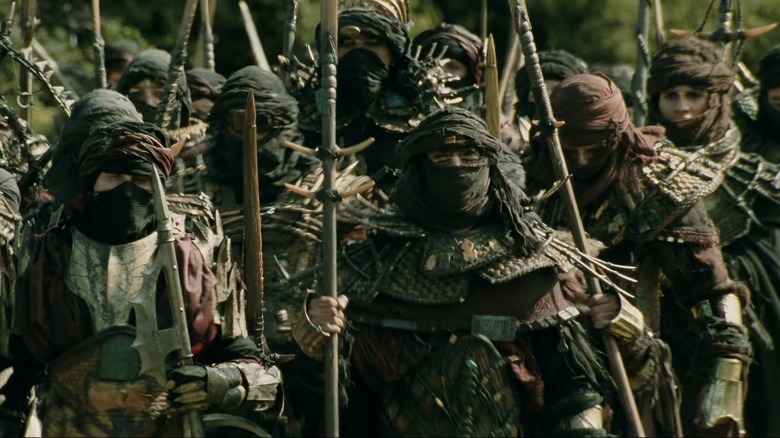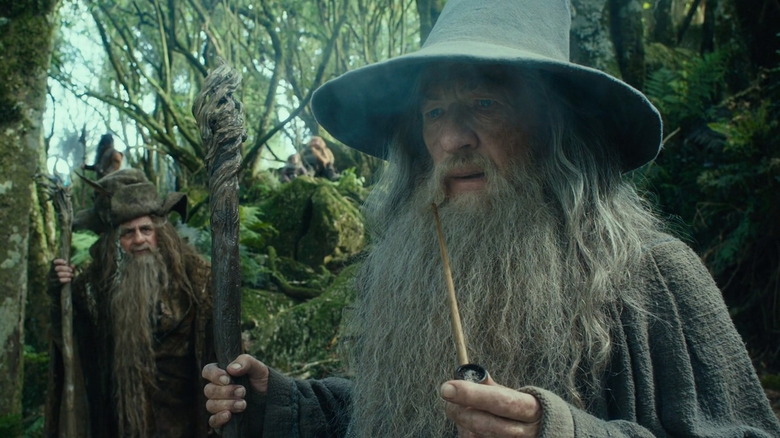Every Villain That Might Appear In Amazon's Lord Of The Rings Series
We may receive a commission on purchases made from links.
Amazon's upcoming Middle-earth television series, currently operating under the working title of "The Lord of the Rings," is set to be the studio's biggest ever production. In 2021, The Hollywood Reporter confirmed rumors that suggested the show's budget would amount to nearly half a billion dollars, putting the final figure at $465 million for the first season alone.
Over the past couple of years, a number of details have emerged about the series. In 2019, Amazon revealed that it will take place primarily during the Second Age of Middle-earth, some 5,000 years prior to the adventures of the Fellowship of the Ring. In 2021, the studio released a brief glimpse of a scene from the show, depicting what appears to be the Two Trees of Valinor towering above the Undying Lands. We've also got a substantial cast list (via The Hollywood Reporter) and a full roster of producers, directors, and writers.
As for actual plot details? Nobody's got a clue. There are a few key story beats to the Second Age — such as the forging of the Rings of Power, the fall of Númenor, and the War of the Last Alliance — but Tolkien never explored this era in much detail. There are any number of narratives the show could follow, locations it could visit, or heroes it could spotlight. One thing you can bet on, however, is that it'll be awash with the nastiest villains and monsters Middle-earth has ever known. Here's every villain that might appear in Amazon's "The Lord of the Rings" series.
Sauron
If there's one villain who is an absolute dead certainty to play a part in Amazon's "The Lord of the Rings," it's Sauron. The ongoing struggle against the Dark Lord is the driving force behind practically everything that happens during the mid-to-late Second Age, and there's really no conceivable situation in which Sauron doesn't act as the show's main antagonist.
Fans of Peter Jackson's "The Lord of the Rings" trilogy will remember Sauron's appearance during the prologue to "The Fellowship of the Ring," in which the desperate Dark Lord took to the battlefield looking like an extremely angry fork — but the Sauron of the Second Age is a very different being. He first appears in disguise to the elves under the name "Annatar," who Tolkien himself describes as bearing a hue of "one both fair and wise." Essentially, this means that the Sauron of Amazon's "The Lord of the Rings" is bound to look a whole lot easier on the eyes than you might expect.
Sadly, nobody has any idea who might be playing the role. In 2019, Deadline reported that "Game of Thrones" actor Joseph Mawle had been cast as "Oren," the show's lead villain, but a production leak in late 2021 suggested that "Oren" is a codename for a character named Adar, who is actually a "corrupted" elvish warlord. As of now, the Dark Lord's true identity remains a mystery — and it's likely to remain that way for some time yet.
The Nazgûl
Where Sauron goes, the Nazgûl are sure to follow. The Black Riders are among the most notorious villains in J.R.R. Tolkien's "The Lord of the Rings," and the Amazon series' creative team are unlikely to pass up the opportunity to include them in their own story. Luckily, the Nine are very much active during Middle-earth's Second Age. Described by Tolkien as "kings, sorcerers, and warriors of old," each of these powerful men were gifted a Ring of Power, thereafter obtaining "glory," "great wealth," and "unending life." Before long, however, they had become twisted into Sauron's servants, forced to walk unseen in the realm of shadows. As Tolkien writes, "Darkness went with them, and they cried with the voices of death."
Peter Jackson touched on the roots of the Nazgûl (and the Witch-King of Angmar in particular) in "The Hobbit: The Desolation of Smaug," but the actual fall of the Nine has never been depicted onscreen. Unsurprisingly, Amazon hasn't exactly been forthcoming about the involvement of the Ringwraiths; as such, we have no idea who could be playing them, what they might look like, or how much of their story we'll get to see. But considering the Second Age is the era in which they first fall to darkness — as well as the fact that three of them come from Númenor, where much of the series is certain to take place — it's probably fair to say that they're very likely to make an appearance.
Ar-Pharazôn
Ar-Pharazôn the Golden will be a less familiar name to casual fans of "The Lord of the Rings." Ar-Pharazôn is a Númenorean who, towards the end of the Second Age, comes to the throne of the powerful kingdom after forcibly marrying Míriel, daughter of the old king, Tar-Palantir.
Tolkien writes that Ar-Pharazôn is a man "restless and eager for wealth and power" who often leads the Númenoreans in their colonial conquests of Middle-earth. It's under his rule that the kingdom's persecution of the "elf-friends" reaches a peak, and it's he who defeats Sauron and takes the Dark Lord as his willing prisoner. Sauron later manipulates Ar-Pharazôn into launching an invasion of the Undying Lands, bringing about the wrath of the god-like Valar and the total destruction of Númenor.
Several leaks have suggested that Ar-Pharazôn will be an important player in the Amazon series, even as early as the first season. He appears on the (unverified) character sheet that leaked in 2021, for example, on which he is described as the "Queen's right hand." His involvement would also line up with a report leaked by the Fellowship of Fans YouTube channel claiming that Isildur, future king of Gondor, will be one of the show's main characters.
Anyone could be playing Ar-Pharazôn in the series, with potential candidates from the cast list including Trystan Gravelle, Simon Merrells, or Peter Mullan. Or it could be somebody else — we really have no idea.
Black Númenóreans
At the end of Book Five of "The Return of the King," Aragorn and his compatriots are confronted by the Mouth of Sauron, a devoted messenger and servant of the Dark Lord. Although he appears only briefly, Tolkien chooses to give the Mouth of Sauron a little expository background in "The Lord of the Rings," writing that "he was a renegade, who came of the race of those that are named the Black Númenóreans."
The Black Númenóreans are among the cruelest men living in Middle-earth during the latter Second Age, having emerged from the anti-Valar faction known as the King's Men. Before the destruction of Númenór, they embark on imperial campaigns in Middle-earth, establishing "lordships" in the southern regions of Umbar and Harad; after the Downfall, they openly ally with Sauron in his war against the Free Peoples of Middle-earth.
If Tolkien's writings are anything to go by, a Black Númenórean could make for a pretty terrifying antagonist. In "The Return of the King," it's said that he gains favor with Sauron thanks to his cunning ways, and as a result "he learned great sorcery, and knew much of the mind of Sauron; and he was more cruel than any orc." It's easy to imagine that a similar character, or characters, might act as a foil to the orcs in the Amazon series, giving a very human face to the evil of Sauron's reign.
Shelob
A prominent figure in the recurring nightmares of arachnophobes everywhere, Shelob is also one of the creepiest creatures to have appeared in "The Lord of the Rings." As the guardian of the pass of Cirith Ungol, it's Shelob who hunts down Frodo and Sam as they attempt to gain entry to Mordor.
Anyone who's ever read "The Silmarillion" will be able to tell you that Shelob is one of the children of Ungoliant, a monstrous evil spirit who allies with the first Dark Lord, Morgoth, to destroy the light of the Two Trees of Valinor. After their tenuous friendship sours, Ungoliant attempts to devour Morgoth before being overcome by his Balrog bodyguards; in the end, Ungoliant disappears from the history of Middle-earth, although Tolkien himself suggests that she may have ended up consuming herself.
As she is a spawn of Ungoliant herself, it can be inferred that Shelob is many, many thousands of years old, having been born as far back as the First Age. Although she would have once lived in Ungoliant's lair of Nan Dungortheb, the destruction of the region of Beleriand likely forced her to relocate to Mordor — and that's exactly where she will be living during the Second Age. Mordor itself is sure to be an important location for the Amazon series, of course, and it's entirely possible that we'll get to see a little more of Cirith Ungol, too. And if that comes to pass, well... Let's just say those nightmares won't be letting up anytime soon.
The Balrog
Gandalf the Grey's confrontation with the Balrog of Moria is one of the most memorable passages in the novel version of "The Lord of the Rings," and it's by far the most iconic moment depicted in Peter Jackson's adaptation of the story. If you're hoping to see one of these demonic creatures make an appearance in Amazon's "The Lord of the Rings," well, we've got bad news and good news.
The bad news is that there's almost no chance whatsoever of that specific Balrog turning up. Better known as Durin's Bane, Gandalf's foe is mentioned by Tolkien to have "lain hidden at the foundations of the earth since the coming of the Host of the West." Here, the author is referring to the War of Wrath, a world-shattering conflict that took place at the very end of the First Age. This means that Durin's Bane was sleeping under Moria for the entirety of the Second Age.
The good news, however, is that, according to Tolkien himself, Morgoth counted as many as seven Balrogs among his personal entourage. Durin's Bane was one, and another was Gothmog, who was slain by the elf Ecthelion during the Fall of Gondolin. One more, who is given no name, was killed by Glorfindel during the same battle. The rest, however, are unaccounted for. Who's to say that Durin's Bane was the sole survivor of the War of Wrath? As it stands, there's no contradiction by Tolkien himself to prevent Amazon's writers from bringing a Balrog into the upcoming series.
The Watcher in the Water
Of course, the Balrog isn't the only creature lurking beneath Middle-earth. In "The Fellowship of the Ring," Gandalf's attempt to lead the Fellowship through Moria is almost defeated when the group is attacked by the so-called Watcher in the Water.
Tolkien describes this creature as akin to a "host of snakes" with "long, sinuous" tentacles. The Watcher features in the novel for less than a full page, but in that short time it very nearly kills Frodo and brings the doors of Moria down on the Fellowship, preventing them from turning back. While Tolkien gives no indication as to what the Watcher in the Water actually is, it likely has some relation to the "Nameless Things" that Gandalf claims live in the deep pits of Middle-earth; these creatures are said to be as old as the world itself and unknown even to Sauron.
Now, it's practically a given that Amazon's "The Lord of the Rings" will journey into Khazad-dûm, considering the kingdom was at its zenith during the Second Age. Indeed, an official synopsis for the show released in 2021 teased that at least some of the story will take place in "the darkest depths of the Misty Mountains." There would certainly be no better way to bring some real peril to the houses of the dwarves — or hint towards Khazad-dûm's future demise — than to explore the mystery of Tolkien's darkest and most enigmatic monsters.
Dragons
J.R.R. Tolkien's most famous dragon is, of course, Smaug. The scourge of Erebor is met by Bilbo towards the end of "The Hobbit," before being shot down and killed by Bard the Bowman during the attack on Lake-town.
In "The Hobbit," Smaug describes himself during his attack on the Lonely Mountain as "young and tender," and that event took place towards the end of the Third Age, so he's unlikely to make an appearance in Amazon's "The Lord of the Rings." Luckily — or unluckily, if you're a denizen of Middle-earth – there are always other dragons.
Although Morgoth's worms are at their most prolific during the First Age, many are said to have fled the War of Wrath, eventually establishing their own realm in the Withered Heath, located in the northern regions of Middle-earth. Now, there's no real indication that these creatures ever owed their allegiance to Sauron (having been bred and controlled by his master, Morgoth) but Tolkien writes in "The Lord of the Rings" that dragons began to stir in the Third Age "when evil reappeared," referencing the return of the Dark Lord. There must be, therefore, some correlation between the two powers — and it stands to reason that the dragons of the Second Age also took to the skies when Sauron first rose to power.
Southrons and Easterlings
One of the most exciting prospects for Amazon's "The Lord of the Rings" series is that it will likely explore as-yet-unseen corners of Middle-earth. Indeed, the map the studio released in 2019 to announce the Second Age setting is marked with places such as "Harad," "Rhûn," and "Khand."
We've actually met the inhabitants of these lands before. Both the Haradrim and the Easterlings play important roles in "The Lord of the Rings": the Haradrim hail from Harad, as you may have guessed, while the Easterlings come from Rhûn and beyond, and Khand is inhabited by an obscure race of men known as the Variags.
Tolkien made clear in his writing that these regions were either allied with or dominated by Mordor. Not enough is known about the Variags to know what they were up to during the Second Age, but we do know more about the Easterlings and Haradrim. In "The Silmarillion," Tolkien writes that "In the further east Men multiplied; and most of them turned to evil, for Sauron was at work." It appears that the Dark Lord took these Easterlings as his servants and warriors early on in the Second Age, continuing to use them right up until the War of the Ring. Meanwhile, the Haradrim are said to have been caught between the oppression of Númenor and the yoke of Mordor in the Second Age, eventually falling into the service of the latter. Expect to see both peoples, and possibly the Variags too, fighting alongside the orcs in the Dark Lord's armies.
The Blue Wizards
The story of the Blue Wizards is one of the most intriguing mysteries of Middle-earth's vast mythology. They're briefly alluded to by Saruman in "The Two Towers," but they never properly appear in any of Tolkien's works.
Curiously enough, although the other Istari (i.e. Gandalf, Saruman, and Radagast) were sent to guide the Free Peoples during the Third Age, Tolkien suggested later in his life that the Blue Wizards might have arrived during the Second Age. In one of these later writings, he claims that the Blue Wizards had been sent to stir up rebellion in the eastern and southern regions of Middle-earth. He also writes that they were successful in their task, having "very great influence on the history of the Second Age and Third Age."
An earlier interpretation, however, has the Blue Wizards taking on a much more sinister role. In Letter 211, written in 1958, Tolkien says, "I think they went as emissaries to distant regions, East and South, far out of Númenórean range: missionaries to 'enemy-occupied' lands, as it were ... and I suspect they were founders or beginners of secret cults and 'magic' traditions that outlasted the fall of Sauron."
Should the Amazon series opt to tell Tolkien's earlier version of the tale, the Blue Wizards might appear as villains, wielding strange powers and ruling their own factions in the far-off lands of Middle-earth. If nothing else, this would be fascinating new territory for "The Lord of the Rings."
Adar
Let's return to Joseph Mawle. As previously mentioned, this "Game of Thrones" alumnus was reported by Deadline to have been cast in Amazon's "The Lord of the Rings" as a character named "Oren." If the 2021 production leak is to be believed, however, "Oren" is simply a codename for Adar, who is said to be an "elf, tortured, corrupted, turned into a warlord."
Around the same time that this leak emerged, the YouTube channel Fellowship of Fans revealed a little more about Adar's alleged role in the series. According to Fellowship of Fans, Adar is present alongside a hooded figure, thought to be Sauron, on a set resembling a human village. Apparently, this elf-warlord is in command of a band of orcs, whom he leads in a "chant" in worship of the hooded figure — although FoF also says that Adar and the figure actually face off against each other at one point.
The notion of a corrupted elf serving Sauron is one unlike anything to have appeared in Tolkien's works. The closest approximation would be Maeglin, son of the so-called dark elf Eöl, who betrays the location of the hidden city of Gondolin to Morgoth during the First Age. Nevertheless, the apparent nature of Adar's character seems to suggest that Amazon's creative team are willing to take bold steps with their story... and that some of the show's villains may yet emerge from unexpected corners of Middle-earth.
Morgoth
Nobody's really expecting Morgoth, the Dark Lord of the First Age, to actually show up during Amazon's "The Lord of the Rings" — except maybe during a prologue sequence. That said, Morgoth's influence is likely to be felt far more than it ever was during the "Lord of the Rings" novels and movies.
During the Second Age, Morgoth's legacy lives on in Sauron. Thousands of years earlier, Sauron had acted as one of Morgoth's chief lieutenants, and many of his cruelest atrocities during the Second Age were committed in his master's name. In fact, Tolkien specifically writes that Sauron "rose like a shadow of Morgoth and a ghost of his malice, and walked behind him on the same ruinous path down into the Void." During his time on Númenor, Sauron even establishes a Morgoth-worshipping cult, building a great temple in the island's capital city and offering human sacrifices to the original Dark Lord.
So while Morgoth himself may not warrant more than the occasional mention in Tolkien's "The Lord of the Rings," there's a reasonable chance that his name, and his evil, will linger on throughout Amazon's series.
